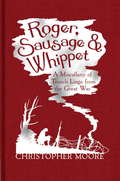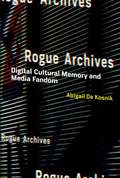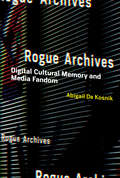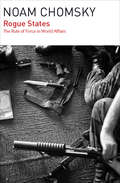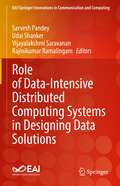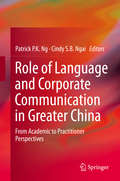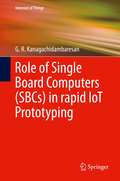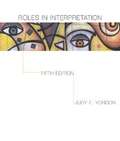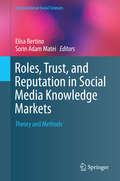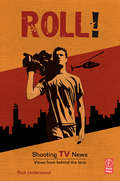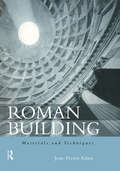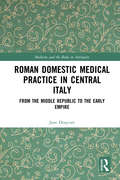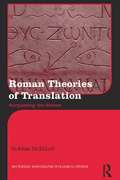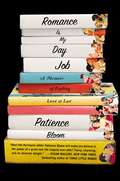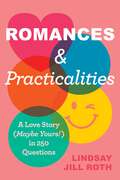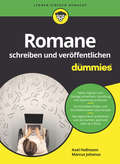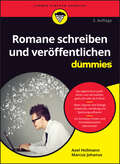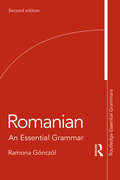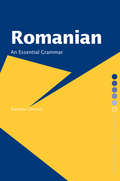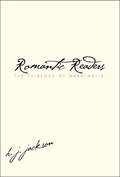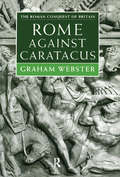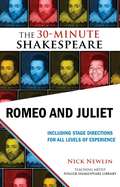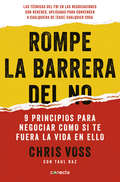- Table View
- List View
Roger, Sausage and Whippet: A Miscellany of Trench Lingo from the Great War
by Christopher MooreRoger: A code word for a gas cylinder and a nickname for rum. Sausage: An observation balloon. Whippet: A small, light type of tank with a top sped of eight m.p.h. The First World War raged for four years, taking with it hundreds of thousands of young soldiers who lived and died together, bonded by the horror of the war. Now, all the way from the trenches and through the letters of Christopher Moore's Captain Cartwright, comes an extraordinary lexicon of the phrases and lingo of life at the front. Whether born from the desperation of gallows humour ('If it keeps on like this, someone's going to get hurt'), borrowed from Cockney rhyming slang, Latin, French and other languages ('Cushy: Comfortable, safe, pleasant. From the Hindustani: khush, pleasure') or even taken from the name of the Huntley and Palmer biscuit company, Tommy had a new word for almost everything. From Ammo to Zig-Zag, this is a fascinating glimpse into the world of our First World War heroes. So fetch the dooly and the other makings, brew up some char, and read on safe in the knowledge that you won't be going over the top today...
Rogers v. Rogers: The Battle for Control of Canada's Telecom Empire
by Alexandra PosadzkiA riveting, deeply reported account that takes us inside the dramatic battle for control of Canada&’s largest wireless carrier, and paints a broader picture of the cutthroat telecom industry, the labyrinth of regulatory and political systems that govern it, and the high-stakes corporate games played by the Canadian establishment. Alexandra Posadzki&’s ground-breaking coverage in the Globe and Mail exposed one of the most spectacular boardroom and family dramas in Canadian corporate history—one that has pitted the company&’s extraordinarily powerful chairman and controlling shareholder, Edward Rogers, against not only his own management team but also the wishes of his mother and two of his sisters. Hanging in the balance is no less than the pending $20 billion acquisition of Shaw Communications, a historic deal that promises to transform Rogers into the truly national telecom empire that its late founder, Ted Rogers, always envisioned. Based on deeply sourced, investigative reporting of the iconic $30 billion publicly traded telecom and media giant, Posadzki takes us inside a company that touches the lives of millions of Canadians, challenging what we thought we knew about corporate governance and who really holds the power. Rogers v. Rogers is also a story of family legacy and succession, of an old guard pushing back at the new guard, and of a company struggling to find its footing in the wake of its legendary founder&’s death. At the heart of it all is a dispute between warring factions of the family over how they each interpret the desires of the late patriarch and the very identity of the company that bears their name.
Rogue Archives: Digital Cultural Memory and Media Fandom
by Abigail De KosnikThe task of archiving was once entrusted only to museums, libraries, and other institutions that acted as repositories of culture in material form. But with the rise of digital networked media, a multitude of self-designated archivists -- fans, pirates, hackers -- have become practitioners of cultural preservation on the Internet. These nonprofessional archivists have democratized cultural memory, building freely accessible online archives of whatever content they consider suitable for digital preservation. In Rogue Archives, Abigail De Kosnik examines the practice of archiving in the transition from print to digital media, looking in particular at Internet fan fiction archives.De Kosnik explains that media users today regard all of mass culture as an archive, from which they can redeploy content for their own creations. Hence, "remix culture" and fan fiction are core genres of digital cultural production. De Kosnik explores, among other things, the anticanonical archiving styles of Internet preservationists; the volunteer labor of online archiving; how fan archives serve women and queer users as cultural resources; archivists' efforts to attract racially and sexually diverse content; and how digital archives adhere to the logics of performance more than the logics of print. She also considers the similarities and differences among free culture, free software, and fan communities, and uses digital humanities tools to quantify and visualize the size, user base, and rate of growth of several online fan archives.
Rogue Archives: Digital Cultural Memory and Media Fandom
by Abigail De KosnikAn examination of how nonprofessional archivists, especially media fans, practice cultural preservation on the Internet and how “digital cultural memory” differs radically from print-era archiving.The task of archiving was once entrusted only to museums, libraries, and other institutions that acted as repositories of culture in material form. But with the rise of digital networked media, a multitude of self-designated archivists—fans, pirates, hackers—have become practitioners of cultural preservation on the Internet. These nonprofessional archivists have democratized cultural memory, building freely accessible online archives of whatever content they consider suitable for digital preservation. In Rogue Archives, Abigail De Kosnik examines the practice of archiving in the transition from print to digital media, looking in particular at Internet fan fiction archives.De Kosnik explains that media users today regard all of mass culture as an archive, from which they can redeploy content for their own creations. Hence, “remix culture” and fan fiction are core genres of digital cultural production. De Kosnik explores, among other things, the anticanonical archiving styles of Internet preservationists; the volunteer labor of online archiving; how fan archives serve women and queer users as cultural resources; archivists' efforts to attract racially and sexually diverse content; and how digital archives adhere to the logics of performance more than the logics of print. She also considers the similarities and differences among free culture, free software, and fan communities, and uses digital humanities tools to quantify and visualize the size, user base, and rate of growth of several online fan archives.
Rogue States: The Rule of Force in World Affairs (Chomsky Perspectives Ser. #No. 13)
by Noam ChomskyThe bestselling author and activist &“has delivered another impressive argument that the U.S. flouts international law when it finds it convenient to do so&” (Publishers Weekly). In this still-timely classic, Noam Chomsky argues that the real &“rogue&” states are the United States and its allies. Chomsky turns his penetrating gaze toward US involvement in the Middle East, Southeast Asia, the Caribbean, and Latin America to trace the enduring combined effects of military domination and economic imperialism on these regions. &“Noam Chomsky is like a medic attempting to cure a national epidemic of selective amnesia . . . [Rogue States is] a timely guide to the tactics that the powerful employ to keep power concentrated and people compliant . . . Chomsky&’s work is crucial at a time when our empire perpetually disguises its pursuit of power under the banners of &‘aid,&’ &‘humanitarian intervention,&’ and &‘globalization.&’ Americans have to begin deciphering the rhetoric. Chomsky&’s a good place to start.&” —The Village Voice &“World-famous MIT linguist Chomsky has long kept up a second career as a cogent voice of the hard left, excoriating American imperialism, critiquing blinkered journalists and attacking global economic injustice.&” —Publishers Weekly &“Nothing escapes [Chomsky&’s] attention . . . [Rogue States is] wonderfully lucid.&” —PeaceWork Praise for Noam Chomsky &“Chomsky is a global phenomenon . . . perhaps the most widely read voice on foreign policy on the planet.&” —The New York Times Book Review &“The conscience of the American people.&” —New Statesman &“One of the radical heroes of our age . . . a towering intellect . . . powerful, always provocative.&” —The Guardian
Role Mate to Soul Mate: The Seven Secrets to Lifelong Love
by Warren FarrellNew York Times bestselling author Dr. Warren Farrell reveals solutions to the seven most important barriers to sustaining love—practices that have helped thousands of real couples rediscover their "soul mate" spark. When Dr. Farrell began teaching couples&’ communication 30 years ago, he taught the wisdom of not being defensive in response to criticism. However, when a couple returned home and a criticism inevitably appeared, that wisdom disappeared. Couples needed to not just be taught this, but to practice both in the workshop and at home. With the help of decades of post-workshop feedback from real couples, Farrell perfected six mindsets that the couples found most effective to embrace criticism as an opportunity to feel more deeply loved—even while they are being criticized. Role Mate to Soul Mate guides couples on how to do this for two hours per week as a &“Caring and Sharing Practice.&” For the other 166 hours, couples create a &“Conflict-Free Zone&” the other 166 hours, which requires preventing criticisms from becoming conflicts. To do this, you&’ll learn how to: Appreciate your loved one with five levels of specificity, both creatively and consistently Transform the &“Four Depleters of Love&” (Criticisms, Complaining, Complacency, and Controlling) into ways to deepen love Master the eleven &“Soulmate Wisdoms&” Play together, because &“couples that play together stay together&” Create win-win solutions to your stickiest problems Apply your new skills to family, friends, colleagues—and even political opponents Since falling in love is natural but sustaining love is unnatural, making these skills come naturally requires an evolutionary shift that is both an art and a discipline. The Role Mate to Soul Mate reward? A deeper, dynamic, and lifelong love.
Role of Data-Intensive Distributed Computing Systems in Designing Data Solutions (EAI/Springer Innovations in Communication and Computing)
by Vijayalakshmi Saravanan Sarvesh Pandey Udai Shanker Rajinikumar RamalingamThis book discusses the application of data systems and data-driven infrastructure in existing industrial systems in order to optimize workflow, utilize hidden potential, and make existing systems free from vulnerabilities. The book discusses application of data in the health sector, public transportation, the financial institutions, and in battling natural disasters, among others. Topics include real-time applications in the current big data perspective; improving security in IoT devices; data backup techniques for systems; artificial intelligence-based outlier prediction; machine learning in OpenFlow Network; and application of deep learning in blockchain enabled applications. This book is intended for a variety of readers from professional industries, organizations, and students.
Role of Language and Corporate Communication in Greater China
by Patrick P.K. Ng Cindy S.B. NgaiThis book features not only the latest trends but also academic and industry practitioner stakeholders' perspectives on language and functional role issues facing the rapidly developing corporate communication (CC) profession in the Greater China region. The book also explores the implications for Western societies that cross-culturally engage with Chinese partners in CC practices. The book's chapters are oriented on five main themes, namely: Development of the CC Profession, Bilingual Practices in Corporate Communication, Corporate Social Responsibility, Employee Communications, and Media Discourse & Persuasive Communication. The first two cluster themes feature a review of the PR/CC profession's evolutionary path to its current status as a more distinct and diversified CC profession emphasizing the role of language and particularly the bilingualism phenomenon, whereas the other cluster themes, which adopt the perspectives of academics and those of CC practitioners, span from cross-cultural, profession-wide and bilingual communication issues to applications of heuristic knowledge within industry-specific workplace contexts.
Role of Single Board Computers (Internet of Things)
by G. R. KanagachidambaresanThis book presents how to program Single Board Computers (SBCs) for Internet of Things (IoT) rapid prototyping with popular tools such as Raspberry Pi, Arduino, Beagle Bone, and NXP boards. The book provides novel programs to solve new technological real-time problems. The author addresses programming, PCB design and Mechanical Cad design all in single volume, easing learners into incorporating their ideas as prototype. The aim of the book is to provide programming, sensors interfacing, PCB design, and Mechanical Cad design to and create rapid prototyping. The author presents the methodologies of rapid prototyping with KiCAD design and Catia software, used to create ready to mount solutions. The book covers scripting- based and drag/drop- based programming for different problems and data gathering approach.
Roles in Interpretation (Fifth Edition)
by Judy E. YordonInterpretation is an artistic process of studying literature through performance and sharing that study with an audience. Yordon's Roles in Interpretation prepares students for the roles they will play in performances by explaining interpretation through a wide variety of literary forms, performance styles, and recent theories of interpretation.
Roles, Trust, and Reputation in Social Media Knowledge Markets
by Sorin Adam Matei Elisa BertinoKnowledge and expertise, especially of the kind that can shape public opinion, have been traditionally the domain of individuals holding degrees awarded by higher learning institutions or occupying formal positions in notable organizations. Expertise is validated by reputations established in an institutionalized marketplace of ideas with a limited number of "available seats" and a stringent process of selection and retention of names, ideas, topics and facts of interest. However, the social media revolution, which has enabled over two billion Internet users not only to consume, but also to produce information and knowledge, has created a secondary and very active informal marketplace of ideas and knowledge. Anchored by platforms like Wikipedia, YouTube, Facebook and Twitter, this informal marketplace has low barriers to entry and has become a gigantic and potentially questionable, knowledge resource for the public at large. Roles, Trust and Reputation in Social Media Knowledge Markets will discuss some of the emerging trends in defining, measuring and operationalizing reputation as a new and essential component of the knowledge that is generated and consumed online. The book will propose a future research agenda related to these issues. The ultimate goal of research agenda being to shape the next generation of theoretical and analytic strategies needed for understanding how knowledge markets are influenced by social interactions and reputations built around functional roles. The authors, including leading scholars and young innovators, will share with the readers some of the main lessons they have learned from their own work in these areas and will discuss the issues, topics and sub-areas that they find under-studied or that promise the greatest intellectual payoff in the future. The discussion will be placed in the context of social network analysis and "big data" research. Roles, Trust and Reputation in Social Media Knowledge Markets exposes issues that have not been satisfactorily dealt with in the current literature, as the research agenda in reputation and authorship is still emerging. In a broader sense, the volume aims to change the way in which knowledge generation in social media spaces is understood and utilized. The tools, theories and methodologies proposed by the contributors offer concrete avenues for developing the next generation of research strategies and applications that will help: tomorrow's information consumers make smarter choices, developers to create new tools and researchers to launch new research programs.
Roll! Shooting TV News: Views from Behind the Lens
by Rich UnderwoodRoll! Shells fly overhead as night-scopes capture deadly fire fights with an eerie green hue, a category 5 hurricane devastates the Big Easy, hidden cameras enter a Cambodian village of brothels and a veteran journalist interviews himself throughout his own brain surgery. Part non-fiction drama, part trade publication, part text book, all woven together giving the reader a look through the viewfinders of the very best television photojournalists. As 19 experts weigh in with their candid, personal stories and photographic tips, it's as if you're over their shoulders, following their intuitions and hearing their thoughts as they shoot. The trade term for what they do is called ENG (Electronic News Gathering) and whether they're called Cameramen, Backpack Journalists, Television Photographers or any other moniker de jour, they're all paid to bring the world's events into living rooms around the world. These are the men and women who capture the bleeding edge of history - as it happens.Written in a smooth, unique interview style, this book is a necessary read for photojournalists, videographers and tv photojournalists.
Roman Building: Materials and Techniques
by Jean-Pierre AdamWith over 750 illustrations, Roman Buildings is a thorough and systematic examination of Roman architecture and building practice, looking at large-scale public buildings as well as more modest homes and shops. Placing emphasis on the technical aspects of the subject, the author follows the process of building through each stage -- from quarry to standing wall, from tree to roof timbers -- and describes how these materials were obtained or manufactured. The author also discusses interior decoration and looks at the practical aspects of water supply, heating and roads.
Roman Domestic Medical Practice in Central Italy: From the Middle Republic to the Early Empire (Medicine and the Body in Antiquity)
by Jane DraycottRoman Domestic Medical Practice in Central Italy examines the roles that the home, the garden and the members of the household (freeborn, freed and slave) played in the acquisition and maintenance of good physical and mental health and well-being. Focussing on the period from the middle Republic to the early Empire, it considers how comprehensive the ancient Roman general understanding of health actually was, and studies how knowledge regarding various aspects of health was transmitted within the household. Using literary, documentary, archaeological and bioarchaeological evidence from a variety of contexts, this is the first extended volume to provide as comprehensive and detailed a reconstruction of this aspect of ancient Roman private life as possible, complementing existing works on ancient professional medical practice and existing works on domestic medical practice in later historical periods. This volume offers an indispensable resource to social historians, particularly those that focus on the ancient family, and medical historians, particularly those that focus on the ancient world.
Roman Theories of Translation: Surpassing the Source (Routledge Monographs in Classical Studies)
by Siobhán McElduffFor all that Cicero is often seen as the father of translation theory, his and other Roman comments on translation are often divorced from the complicated environments that produced them. The first book-length study in English of its kind, Roman Theories of Translation: Surpassing the Source explores translation as it occurred in Rome and presents a complete, culturally integrated discourse on its theories from 240 BCE to the 2nd Century CE. Author Siobhán McElduff analyzes Roman methods of translation, connects specific events and controversies in the Roman Empire to larger cultural discussions about translation, and delves into the histories of various Roman translators, examining how their circumstances influenced their experience of translation. This book illustrates that as a translating culture, a culture reckoning with the consequences of building its own literature upon that of a conquered nation, and one with an enormous impact upon the West, Rome's translators and their theories of translation deserve to be treated and discussed as a complex and sophisticated phenomenon. Roman Theories of Translation enables Roman writers on translation to take their rightful place in the history of translation and translation theory.
Romance Is My Day Job
by Patience BloomWho knows the ins and outs of romance better than a Harlequin editor? A surprising and exhilarating look into Patience Bloom's unexpected real-life love story. At some point, we've all wished romance could be more like fiction. Patience Bloom certainly did, many times over. As a teen she fell in love with Harlequin novels and imagined her life would turn out just like the heroines' on the page: That shy guy she had a crush on wouldn't just take her out--he'd sweep her off her feet with witty banter, quiet charm, and a secret life as a rock star. Not exactly her reality, but Bloom kept reading books that fed her reveries. Years later she moved to New York and found her dream job, editing romances for Harlequin. Every day, her romantic fantasies came true--on paper. Bloom became an expert when it came to fictional love stories, editing amazing books and learning everything she could about the romance business. But her dating life remained uninspired. She nearly gave up on love. Then one day a real-life chance at romance made her wonder if what she'd been writing and editing all those years might be true. A Facebook message from a high school friend, Sam, sparked a relationship with more promise than she'd had in years. But Sam lived thousands of miles away--they hadn't seen each other in more than twenty years. Was it worth the risk? Finally, Bloom learned: Love and romance can conquer all.
Romances & Practicalities: A Love Story (Maybe Yours!) in 250 Questions
by Lindsay Jill RothWith the pop psychology of Malcolm Gladwell and the humor of Carrie Bradshaw, Romances & Practicalities combines a charming personal love story with research-backed self-help, including a set of 250 questions to help you foster deeper intimacy and get honest about what you’re really looking for in a partner.A few months into Lindsay Jill Roth’s whirlwind transatlantic courtship with a handsome Englishman, he made a comment that hit her like a gut-punch: “I don’t know you well enough yet.” Despite hours on FaceTime and swoon-worthy dates in London and NYC, Roth realized he was right: they didn’t know each other very well. And their relationship, while certainly romantic, was hardly practical. Did they even have a shared vision for the future? In the age of increasingly impersonal dating, how do you get off the dating hamster wheel and advance a relationship along the path to commitment? How do you know if you’re with “the one"?Enter Romances & Practicalities, a set of 250 research-backed questions spread across twelve categories—from money to children to chores to sex—designed to help you identify your wants, needs, and non-negotiables, assess compatibility, initiate tricky conversations with grace, and build a deeper, stronger relationship. Questions range from seemingly light and casual to intimate and serious, including:How did your family communicate, share, and argue growing up?How are we different? Might our differences be a source of future conflict?How important to you is alone-time?How important is your career in terms of your identity?How do you feel about debt? Mortgages?If we were stuck on a desert island, what strengths would you bring to help us survive?Roth weaves the questions with her own love story, provocative interviews with couples who’ve used the system, and practical guidance from a diverse range of clinical and popular experts including Lori Gottlieb, Nicole LePera, Mark Hyman, Emily Morse, Suze Orman, Nate Berkus, and Barbara Corcoran.Roth’s wise and witty narrative explores the reasons we don’t often equate romance with practicality, and arrives at a surprising truth: healthy communication isn’t just vital, it’s sexy.
Romane schreiben und veröffentlichen für Dummies (Für Dummies)
by Axel Hollmann Marcus JohanusHaben Sie auch schon einmal mit dem Gedanken gespielt, Ihren eigenen Roman zu schreiben? Dieses Buch begleitet Sie auf Ihrem Weg als Schriftsteller. Axel Hollmann und Marcus Johanus helfen Ihnen, faszinierende Buchideen zu entwickeln, interessante Figuren zu erfinden, fesselnde Dialoge zu schreiben und spannende Handlungsbögen aufzubauen. Außerdem finden Sie in diesem Buch das wichtigste Handwerkszeug, das Sie als Romanautor beherrschen sollten und Möglichkeiten, Ihr Buch als gedrucktes Buch oder E-Book, im Selfpublishing oder bei einem Verlag zu publizieren und zu vermarkten.
Romane schreiben und veröffentlichen für Dummies (Für Dummies)
by Axel Hollmann Marcus JohanusRomane schreiben und veröffentlichen Finden Sie den Roman in sich Haben Sie auch schon einmal mit dem Gedanken gespielt, Ihren eigenen Roman zu schreiben? Dieses Buch begleitet Sie auf Ihrem Weg als Schriftsteller. Axel Hollmann und Marcus Johanus helfen Ihnen, faszinierende Buchideen zu entwickeln, interessante Figuren zu erfinden, fesselnde Dialoge zu schreiben und spannende Handlungsbögen aufzubauen. Außerdem finden Sie in diesem Buch das wichtigste Handwerkszeug, das Sie als Romanautor beherrschen sollten, und Möglichkeiten, Ihren Roman als gedrucktes Buch oder E-Book, im Selfpublishing oder bei einem Verlag zu publizieren und zu vermarkten. Sie erfahren Was es über Drei-Akte-Struktur, Heldenreise und Erzählperspektive zu wissen gibt Wie Sie Ihr Werk überarbeiten Was Sie von Agenten und Verlagen erwarten können Wie Sie sich in den sozialen Medien präsentieren
Romanian: An Essential Grammar (Routledge Essential Grammars)
by Ramona GönczölNow in its second edition, Romanian: An Essential Grammar is a concise, user-friendly guide to modern Romanian. It takes the student through the essentials of the language, explaining each concept clearly and providing many examples of contemporary Romanian usage. This fully revised second edition contains: • a chapter of each of the most common grammatical areas with Romanian and English examples • extensive examples of the more difficult areas of the grammar • a section with exercises to consolidate the learning and the answer key • a list of useful verbs • an appendix listing useful websites for further information • a glossary of grammatical terms used in the book • a useful bibliographical list. Suitable for both classroom use and independent study, this book is ideal for beginner to intermediate students.
Romanian: An Essential Grammar (Routledge Essential Grammars)
by Ramona GönczölThis book is suitable for independent and classroom learners, ideal for the beginner to intermediate student, and takes the reader through the essentials of the language explaining each concept clearly and providing many examples of contemporary Romanian usage. The book contains: a chapter on each of the most common grammatical areas with Romanian and English examples extensive examples of the more difficult areas of the grammar an appendix listing relevant websites for further information on the Romanian language.
Romantic Readers: The Evidence of Marginalia
by H. J. JacksonWhen readers jot down notes in their books, they reveal something of themselves--what they believe, what amuses or annoys them, what they have read before. But a close examination of marginalia also discloses diverse and fascinating details about the time in which they are written. This book explores reading practices in the Romantic Age through an analysis of some 2,000 books annotated by British readers between 1790 and 1830. This period experienced a great increase in readership and a boom in publishing. H. J. Jackson shows how readers used their books for work, for socializing, and for leaving messages to posterity. She draws on the annotations of Blake, Coleridge, Keats, and other celebrities as well as those of little known and unknown writers to discover how people were reading and what this can tell us about literature, social history, and the history of the book.
Rome Against Caratacus: The Roman Campaigns in Britain AD 48-58
by Graham WebsterThe Roman Conquest of Britain in AD 43 was one of the most important turning points in the history of the British Isles. It left a legacy still discernible today in the form of archaeological remain, road networks, land divisions and even language.In his much-acclaimed trilogy, now up-dated and revised, Dr Webster builds up a fascinating and lively picture of Britain in the first century AD and discussed in detail the various types of evidence and the theories based upon it.Caratacus' last stand against the Romans has a central place in the folklore of the Welsh Marches, where many a hill is claimed to be the site of the famous battle. But, as Graham Webster shows, this epic encounter was not only real history but also part of an intricate ten-year series of campaigns conducted after the initial conquest of Britain.By interpreting the ancient historical accounts and piecing together the masses of archaeological evidence, Dr Webster has brilliantly reconstructed this central period of the Claudian Conquest of Britain and its immediate aftermath.
Romeo and Juliet: The 30-Minute Shakespeare
by Nick NewlinPlanning a school or amateur Shakespeare production? The best way to experience the plays is to perform them, but getting started can be a challenge: The complete plays are too long and complex, while scene selections or simplified language are too limited."The 30-Minute Shakespeare" is a new series of abridgements that tell the "story" of each play from start to finish while keeping the beauty of Shakespeare's language intact. Specific stage directions and character suggestions give even inexperienced actors the tools to perform Shakespeare with confidence, understanding, and fun!This cutting of ROMEO AND JULIET is edited to four key scenes, starting with the lyrical prologue and the foreboding opening brawl, which is played out in slow motion to music. Also included are the timeless balcony scene; the harsh scolding of Juliet by her father; and the final moments at the tomb.The edition also includes an essay by editor Nick Newlin on how to produce a Shakespeare play with novice actors, and notes about the original production of this abridgement at the Folger Shakespeare Library's annual Student Shakespeare Festival.
Rompe la barrera del no: 9 principios para negociar como si te fuera la vida en ello
by Chris VossEl prestigioso ex negociador internacional del FBI Chris Voss, especializado en secuestros con rehenes, nos enseña un método de negociación rompedor: tácticas para negociaciones duras que son aplicables en múltiples aspectos de nuestras vidas. Rompe la barrera del no es un manual de negociación imprescindible desarrollado y perfeccionado a lo largo de la extraordinaria carrera de Chris Voss como negociador en secuestros con rehenes y como reconocido profesor en las escuelas de negocio más prestigiosas del mundo. Voss ha puesto a prueba estas técnicas en todo tipo de situaciones y ha comprobado su efectividad, tanto en los inicios de su carrera cuando patrullaba las peligrosas calles de Kansas City como en los cursos que imparte en las mejores universidades. Entre las muchas y distintas personas que han aplicado sus enseñanzas, se encuentran desde clientes que han visto aumentar significativamente los beneficios de sus empresas hasta estudiantes de programas de MBA que han conseguido empleos mejores o incluso padres que tienen que vérselas con sus hijos. Rompe la barrera del no relata los entresijos de situaciones verdaderamente dramáticas y revela las mejores y más eficaces estrategias de negociación. Voss, uno de los mejores negociadores del mundo, nos enseña a emplear estas técnicas en cualquier aspecto de nuestra vida. Reseñas:«Este libro destaca la importancia de la inteligencia emocional sin sacrificar la necesidad de conseguir acuerdos. Escrito por un negociador de rehenes, alguien que no se podía permitir una respuesta negativa, este libro resulta una lectura fascinante y muy práctica. En él encontraremos las técnicas necesarias para alcanzar el acuerdo deseado.»Daniel H. Pink, autor del bestseller Vender es humano «Pocas personas gozan de la experiencia de Chris Voss, ex negociador del FBI en situaciones de secuestros con rehenes. Sus técnicas funcionan, tanto para los negocios como para la vida.»Joe Navarro, agente especial (retirado) del FBI y autor del bestseller internacional El cuerpo habla «Los negocios, y prácticamente todo en la vida, dependen de cómo encaramos determinadas conversaciones cruciales, y estas herramientas nos proporcionan la ventaja que necesitamos... Es una lectura obligatoria para mis empleados, porque yo utilizo las lecciones de este libro cada día, y me gustaría que ellos también lo hicieran.»Jason MacCarthy, CEO de Goruck
